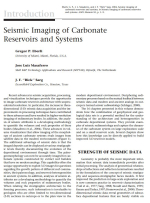Добрый день, Коллеги. Важное сообщение, просьба принять участие. Музей Ферсмана ищет помощь для реставрационных работ в помещении. Подробности по ссылке
Seismic imaging of carbonate reservoirs and systems. Volume 81 / Сейсмическое изображение карбонатных резервуаров и систем
Recent advances in seismic acquisition, processing, and visualization techniques provide the opportunity to image carbonate reservoir architecture with unprecedented resolution. In particular, the increase in threedimensional (3-D) seismic data acquisition and the improvements in processing techniques have contributed to these advances and have resulted in higher-resolution imaging of sedimentary bodies. In addition, the analysis of seismic attributes is a developing methodology to quantify the volumes and rock properties of these bodies (Masaferro et al., 2004). These advances in volume visualization that allow imaging of the morphology of ancient carbonate systems rivals images from satellite data in the modern environments (Figure 1).
The additional advantage of seismic data is that the imaged deposits can be displayed at various stratigraphic levels thereby documenting the evolution of the depositional environment through time. The paleogeomorphology can now be accurately imaged for carbonate systems constructed by extinct reef builders that have no modern analogs. This capability offers the unique opportunity to exploit 3-D images for questions regarding the growth pattern of different reef communities, their paleoecology, and reservoir heterogeneities in ancient systems. In addition, analyses of seismic attributes are a developing methodology to quantify the volumes and rock properties of sedimentary bodies.
When relating the stratigraphic architecture to the forming processes, such information is invaluable to geologists who are often limited to two-dimensional (2-D) sections in outcrops or to the plan view in the modern depositional environment. Deciphering sedimentary processes based on the mutual feedback between seismic data and modern and ancient analogs in outcrops is termed seismic sedimentology (Schlager, 2000). The 16 chapters presented in this volume demonstrate how the combination of geophysical and geological data sets is a powerful method for the understanding of the architecture and heterogeneities in carbonate depositional systems. They provide examples of seismic sedimentology and capture the dynamics of the carbonate system on large exploration scale and on a small reservoir scale. Several chapters show how this knowledge can be directly applied to build improved 3-D reservoir models. <...>




